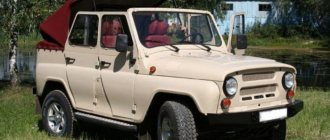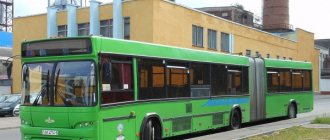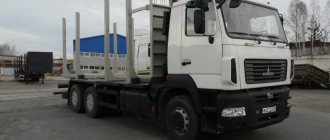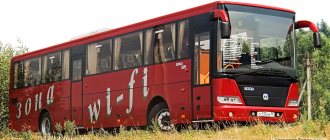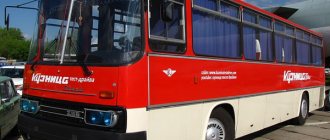The early sixties of the 20th century are characterized as a tense time in relations between the two main world powers: the Soviet Union and the United States. Both countries possessed nuclear weapons. 1963 - The Cuban Missile Crisis, which almost ended in the exchange of nuclear missiles. The wisdom of the leaders of the superpowers prevailed over ambitions, and the war did not happen. At the same time, the Soviet Union was developing protective equipment in case of an enemy nuclear attack. One of the directions was the development of a car with protection from the consequences of a nuclear strike.
Special Army
While PAZ's drive axles and chassis design were original (albeit using serial parts), the 38ASM military bus, which was made in Voronezh, was simply based on GAZ-66 units.
Such machines were assembled on a small scale, and they served only in military units.
38ASM on GAZ-66 chassis
38ASM on GAZ-66 chassis
New 1986 GAZ 66 – from storage, mileage 1400 km
GAZ-66
- Soviet and Russian truck with a 4x4 wheel arrangement, a load capacity of 2.0 tons and a cabin over the engine. The most popular all-wheel drive two-axle truck in the Soviet Army and in the national economy of the USSR and Russia in the 1960s-1990s.
The designer of the car is Alexander Dmitrievich Prosvirnin.
STORY
The first prototypes of the GAZ-66 were created in 1962 as a further development of the 1.2-ton GAZ-62 truck, produced in 1958-1962. (extremely small quantities produced) and the successor to the 2-ton GAZ-63 truck, produced in 1948-1968. Serial production of the GAZ-66 began in July 1964. In 1968, the truck received a centralized tire pressure regulation system (66-01 and modifications).
In 1966 he was awarded a Gold Medal at the exhibition “Modern Agricultural Equipment” in Moscow. In 1967 he was awarded the Gold Medal at the International Fair of Agricultural Machinery in Leipzig. In April 1969, the GAZ-66 was the first Soviet car to receive the State Quality Mark. GAZ-66 was exported to all countries of the socialist camp.
The GAZ-66 was adopted by the Soviet army and was used in the national economy; after the collapse of the USSR, a large number of GAZ-66s began to be used in the Russian army, mainly in the Airborne Forces and border troops.
In 1995, mass production of the GAZ-66-11 with modifications was discontinued. In return, the Gorky Automobile Plant mastered the production of the GAZ-3308 “Sadko” model, unified with the GAZ-3307. The last copy of the GAZ-66-40 rolled off the assembly line on July 1, 1999. A total of 965,941 copies were produced. GAZ-66 family.
Main modifications of GAZ-66 and specialized bodies on its chassis
GAZ-66 on a Soviet postage stamp
- GAZ-66-1 (1964—1968) - the first model without a centralized tire pressure control system
- GAZ-66A (1964-1968) - with winch
- GAZ-34 - a prototype with a 6x6 wheel arrangement
- GAZ-66B (since 1966) - airborne version with a telescopic steering column, folding roof and folding windshield frame
- GAZ-66D (1964-1968) - chassis with power take-off
- GAZ-66P - truck tractor (experienced)
- GAZ-66E (1964-1968) - with shielded electrical equipment
- GAZ-66-01 (1968—1985) - basic model with a centralized tire pressure control system
- GAZ-66-02 (1968—1985) - with winch
- GAZ-66-03 (1964—1968) - with shielded electrical equipment
- GAZ-66-04 (1968—1985) - chassis with shielded electrical equipment
- GAZ-66-05 (1968—1985) - with shielded electrical equipment and winch
- GAZ-66-11 (1985-1996) - modernized base model
- GAZ-66-12 (1985—1996) - with winch
- GAZ-66-14 (1985-1996) - chassis with shielded electrical equipment and power take-off
- GAZ-66-15 (1985—1996) - with shielded electrical equipment and winch
- GAZ-66-16 (1991-1993) - a modernized version with a ZMZ-513.10 engine, reinforced tires (single wheels), modified brakes, a platform without wheel wells (later installed on GAZ-66-11 and GAZ-66-40 ); lifting capacity 2.3 t
- GAZ-66-21 (1993-1995) - national economic modification with double rear axle tires and a wooden platform of the GAZ-53 type, load capacity 3.5 tons.
- GAZ-66-31 - chassis for dump trucks
- GAZ-66-41 (1992-1995) - with naturally aspirated diesel engine GAZ-544
- GAZ-66-40 (1995-1999) - with GAZ-5441 turbodiesel
- GAZ-66-92 (1987-1995) - northern
- GAZ-66-96 - chassis for rotational buses
THIS IS INTERESTING: Laz buses history
Export
- GAZ-66-51 (1968—1985)
- GAZ-66-52 (1968—1985) - with winch
- GAZ-66-81 (1985-1995) - for countries with temperate climates
- GAZ-66-91 (1985-1995) - for countries with tropical climates
Specialized
- AP-2 is a self-dressing unit, the main transport unit of the regiment's medical station.
- AS-66 is an ambulance designed to evacuate the wounded.
- DDA-2 is a disinfection-shower unit, used in military (sometimes in civilian) sanitary and epidemiological units.
- GZSA-731, 983A, 947, 3713, 3714 - “Mail”, “Bread” and “Medicine” vans.
- MZ-66 - oil tanker.
- R-142 - command and staff vehicle
- 3902, 3903, 39021, 39031 - mobile workshops for providing technical assistance to agricultural machinery.
- 2001, 2002, 3718, 3719, 3716, 3924, 39521 - mobile clinics.
- GAZ-SAZ-3511 is an agricultural dump truck on the GAZ-66-31 chassis (assembled in Saransk).
- GAZ-KAZ-3511 is an agricultural dump truck on the GAZ-66-31 chassis (assembled in Bishkek, Kyrgyzstan).
Buses
- NZAS-3964, Volgar-39461 - rotation buses (a comfortable body with seats for passengers was installed on the chassis).
- APP-66 - all-terrain bus, tires with pressure regulation. Produced by the 172 Central Automobile Repair Plant only for the needs of the USSR Ministry of Defense. Until 1987, about 8,000 copies were produced.
- PAZ-3201, all-wheel drive version of PAZ-672.
- PAZ-3206, all-wheel drive version of PAZ-3205.
Technical characteristics of the car GAZ-66-11
| Type | Two axle truck |
| Load capacity | 4,000 kg |
| Permitted maximum weight | 5,940 kg |
| Length | 5 806 mm (with winch) |
| Width | 2 322 mm |
| Canopy height without load | 2,520 mm |
| Cab height with full weight | 2,490 mm |
| Wheelbase | 3 300 mm |
| Ground clearance | 315 mm |
| Front wheel track | 1 800 mm |
| Rear wheel track | 1,750 mm |
| Turning radius | 9.5 m |
| Fording depth (on the bottom) | 0.8 m |
| Engine | ZMZ-66-06 eight-cylinder four-stroke, liquid-cooled |
| Working volume | 4,254 cm3 |
| Power | 120 hp |
| checkpoint | manual 4-speed with synchronizers in 3rd and 4th gears |
| Transfer case | With reduction gear and switchable front axle |
| Drive unit | back or full |
| Wheels | special ones with a split rim and bead ring 8.00-18; tires 12.00-18 |
| Tire pressure | 0.5-3 kg/cm2 |
| Maximum speed with full weight | 90 km/h |
| Fuel tank capacity | 210 l |
| Control fuel consumption, l/100 km at a speed of 60 km/h | 20 |
| Fuel brand | gasoline A-72, A-76, AI-80 |
| Battery capacity | 75 Ah |
| Maximum current of car generator | 85 A |
1986 GAZ 66 new mileage - 1400 km
Box storage. In perfect condition. With pts.
Source: https://xn--80aafe9bhdrpm.com/%D0%BD%D0%BE%D0%B2%D1%8B%D0%B9-1986-%D0%B3%D0%B0%D0%B7-66 -%D0%BF%D1%80%D0%BE%D0%B1%D0%B5%D0%B3-1400-%D0%BA%D0%BC-%D1%81-%D1%85%D1%80 %D0%B0%D0%BD%D0%B5%D0%BD%D0%B8%D1%8F/
All-terrain bus
In 1963, another unique bus was built from a LAZ body and a three-axle ZIL-157 chassis at the Tosnensky Automobile Repair Plant (ordered by the Ministry of Road Transport).
The car with a 6x6 wheel arrangement could accommodate 36 seats. The bus reached speeds of up to 80 km/h, and easily overcame off-road conditions - it had few equals in cross-country ability. But the car did not go into production for a number of reasons.
Tosno-Garo on ZIL-157 chassis
Tosno-Garo on ZIL-157 chassis
All-wheel drive bus AP-6
Unknown firstborn.
All-wheel drive bus AP-6.
Denis Dementyev, photo from the archive of the author and FSUE “21 NIII AT” of the RF Ministry of Defense
Do you know about the very first domestic all-wheel drive passenger bus? I'm willing to bet that this question will lead even the most history-savvy car enthusiast to a dead end. And this is understandable, because an all-terrain passenger bus is a curiosity in the automotive world, even despite the popularization of PAZ brand “all-wheel drive” vehicles in our country. Many can say that the PAZ-3201 was the first. True, experts will remember 38AC. Although in fact, until recently, this title was assigned to an experimental bus on the ZIL-157 chassis of the Tosnensky Automobile Repair Plant produced in 1963. But it turned out that all the laurels did not belong to them, but to the AP-6 bus, manufactured in 1954!
The reason for writing this material was a trip to the 21st Research Testing Institute of the Russian Ministry of Defense, where several reports on testing a hitherto mysterious bus, developed and produced at the Central Automobile Repair Plant No. 101, the history of which we have already discussed, were accidentally found in the annals of the archive. told on the pages of the magazine. But in that article there was not a single mention of the AP-6, since at that time the existence of this bus was not even known. Therefore, in order to restore historical justice, we decided to talk about it separately, especially since the reason for this is not a joke - after all, the first all-wheel drive passenger bus in the USSR. It is not every day in our history that such discoveries occur.
ATARZ-63. 1963
Since we are talking about all-wheel drive buses, we need to decide, what do we know about them? One thing is for sure - there are very few of them. For the entire existence of the domestic automobile industry, only PAZ-3206 buses and its predecessors PAZ-3201 can be called mass-produced, and then with a large degree of convention. To these can be added the very few army passenger buses 38AS and APP-66 based on the GAZ-66-01 chassis, which had carriage-type bodies. Maniacal fans will add to this meager list, for example, the same type of mountain rescue bus 66AG produced by VOEZ (Lugansk). But that's all! This eloquently demonstrates that such designs are rare. Why is it that in a country where one problem competes for primacy with another, four-wheel drive buses are not widely used? In fact, they received it, but in a different, uglier quality - “shift buses” - sort of inferior buses, read trucks, which have a crooked booth installed on a standard chassis, with seats stuck inside. But the Soviet economy never mastered a full-fledged bus body on an all-wheel drive base - several thousand produced PAZ-3201 buses, which made their way onto the assembly line for many years, never became an integral part of the typical rural landscape. Therefore, most of the interesting models of all-terrain buses had mainly military roots, including the pioneer AP-6.
Purpose
The GAZ-66 KZ-1 concept was developed to protect against the consequences of the enemy using nuclear weapons:
- shock wave. According to scientists, up to 50% of the explosion energy is spent on the air wave. The streamlined shape of the car was supposed to protect against its impact;
- light radiation. The flow of radiant energy reaches 7700 degrees at the epicenter of the explosion. Two-layer plastic with insulation was supposed to protect against high-temperature influences;
- penetrating radiation. During an explosion, three types of radiation are released: alpha and beta particles, gamma radiation. For protection, a radiation-attenuating body was provided.
Important!
As a result of tests, the super-streamlined shape of the KZ-1 modification, close to the outline of a ball, increased resistance to shock waves three times compared to a standard rectangular body.
In case of survival after a nuclear explosion, a car must have all-wheel drive, a rigid frame structure, a powerful engine, a streamlined shape, and the body material must protect against major damaging factors. The developed model GAZ-66 KZ-1 met all the assigned tasks. The design was simple and had a long working life.
Characteristics
Represents a small, round, barrel-shaped bus with small windows. Built on the chassis of a GAZ-66 with all-wheel drive. The monolithic frameless structure of the sealed body is made of two-layer fiberglass panels. Between the layers of plastic there was foam insulation.
GAZ-66 as the main frame meets military requirements in terms of dimensions, reliability, strength, and operation in different road and climatic conditions. A powerful engine equipped with an eight-cylinder unit and all-wheel drive provide increased maneuverability. The tire pressure regulation system and high ground clearance make it possible to drive off-road, with a snow depth of 0.8 m, and overcome a terrain slope of 22 degrees in sandy soils. Thanks to the frame design, the car has a large margin of safety.

